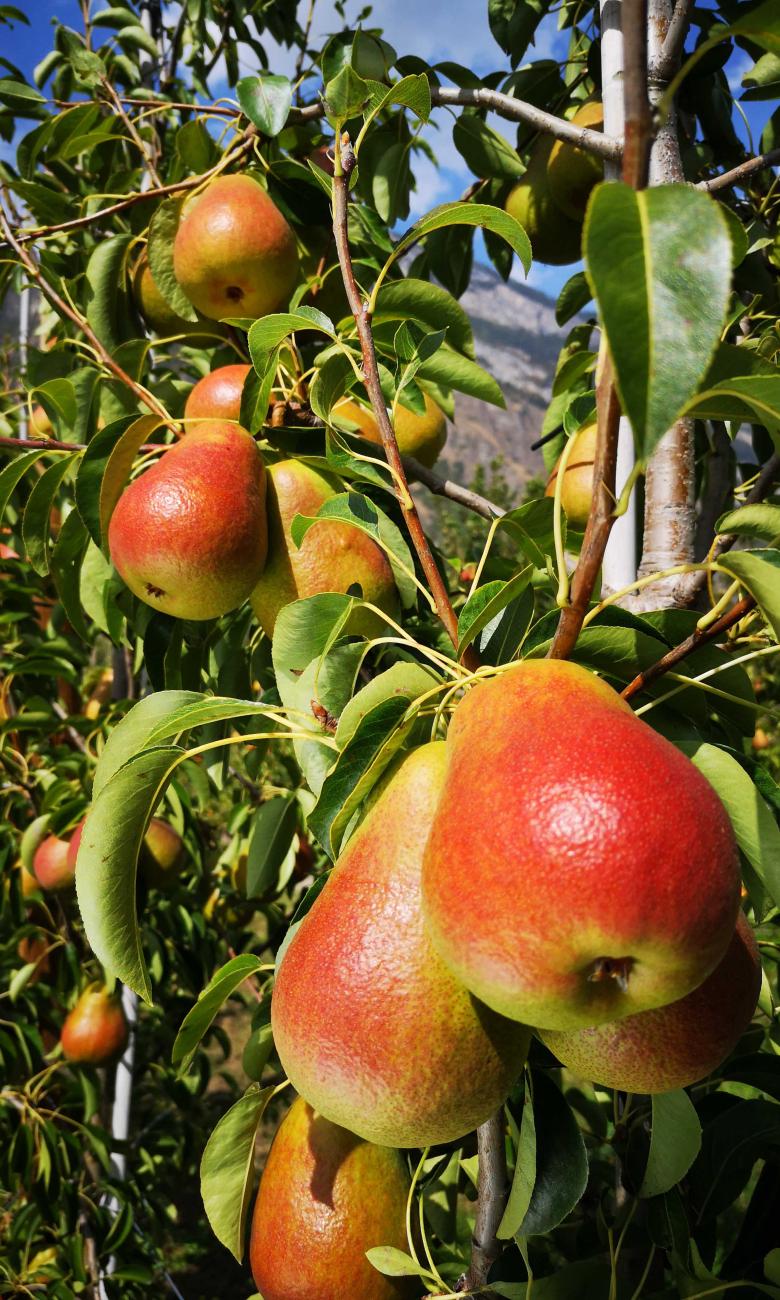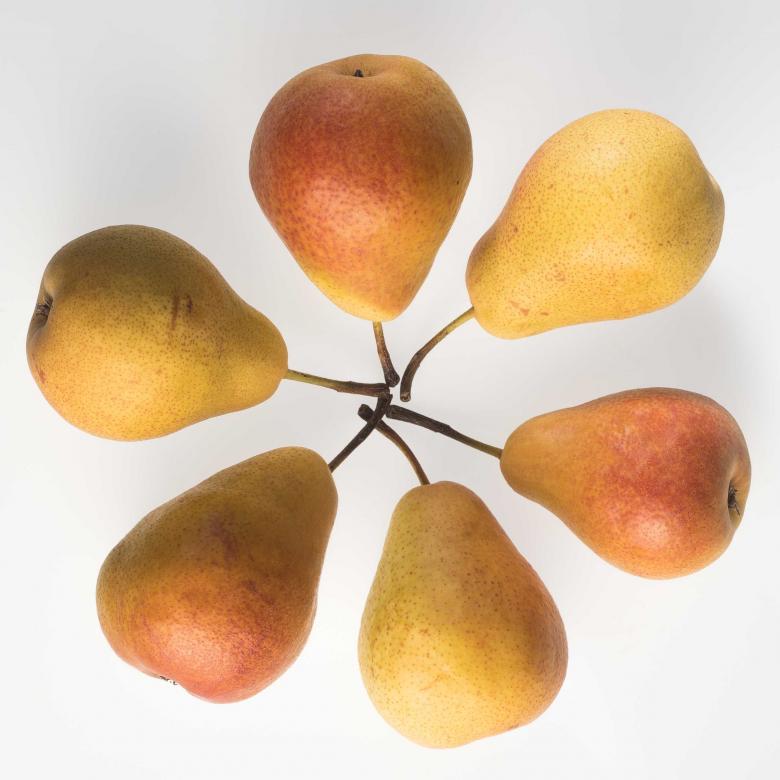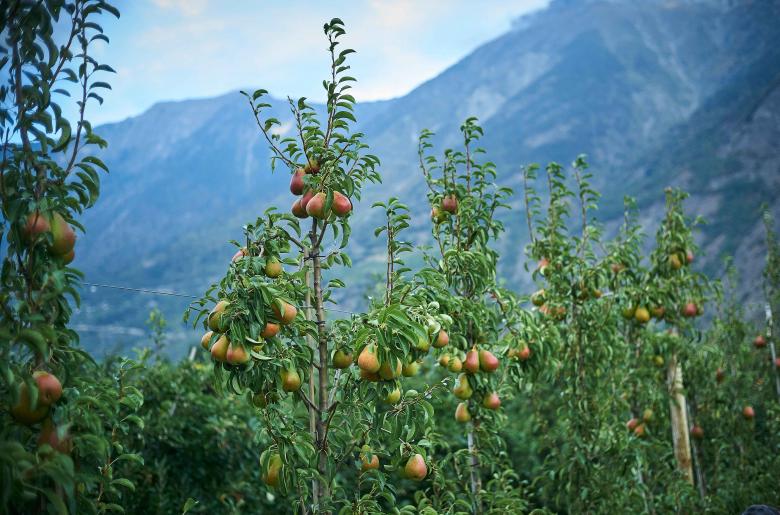The Fred® pear – the fruit of perseverance and expertise
The perfect pear does exist. It's Swiss and it's called Fred®. Launched at the beginning of 2018, the fruit is the culmination of an 18-year breeding programme carried out by researchers at Agroscope, Switzerland's centre of excellence for agricultural research. And at the heart of the process: the desire to produce the ideal pear to satisfy growers, sellers and buyers alike.
Taking a bite out of this pear, who would've thought that it had already journeyed across 11 countries, satisfying the taste buds of hundreds of trained tasters, and surpassing thousands of other varieties to make it onto the store shelves? And who would suspect that this fruit, devoured in just a few minutes, took 18 years to create? Not many for sure. But that's exactly the story behind Fred®, Switzerland's new pear created by Agroscope.

An innovative pear
The story begins in the early 2000s: Charly Rapillard, an agronomist at Agroscope's research centre in Conthey (canton of Valais), crossed different varieties of pear with the goal of creating a shrub resistant to fireblight, a disease that affects fruit trees in particular. One of these experiments crossed the Canadian Harrow Sweet – a delicious variety tolerant to fireblight – with the Dutch Verdi, an attractive-looking red pear with a long shelf life.
When Danilo Christen took up the reins of Rapillard's work a few years later, he was first and foremost intrigued by the results of this Harrow Sweet – Verdi crossbreeding. The rather firm flesh and size of the pear were not typical, but the researcher recognised its huge commercial potential. In fact, Christen had discerned that certain consumers enjoy munching on fruit like apples on the go, rather than eating them after dinner at the table. The Fred® pear, which was juicy but didn't run, seemed very suitable for people with this type of eating habit. The trees also grew quickly, which meant that the pears could be picked earlier and would have longer shelf lives. All of which made Fred® the perfect pear, satisfying the growers, sellers and consumers alike.

Varietal selection – a true art
The selection process begins by crossing pear varieties through hand pollination. This involves brushing pollen from other varieties onto the pear blossom. At the end of the season, the pear seeds are harvested and planted. In this way, the agronomists get hundreds of different shrubs, each with their own genetic composition or genotype. Every genotype constitutes a potential new variety that is assessed over a number of years. "Crossbreeding isn't the complicated part; what's complicated is getting rid of everything that isn't good enough," says Christen about the 3,000 genotypes they have already evaluated.
That is why researchers need patience to examine the characteristics of the trees and their fruit at the end of each season. This monumental task comes in three stages. "The first question you have to ask yourself is this: can the producer live off these trees? " explains Christen. In other words, consideration must be given to the size of the trees, the structure of the branches and the number of years before the fruit can be picked. Then, each fruit is examined to see if there are any blemishes or unwanted russeting; pears that have a uniform size, an ideal shape and look appealing are chosen. Finally the pears are sampled to check the texture of the fruit's surface and the smoothness and taste of its flesh; the skin is tasted separately at the end.

Penetrating the market
"For a selection process to succeed you need know-how, intuition and good luck," says Christen, a winning combination that clearly got the agronomist to try his luck in 2009 with the 'CH201', the Harrow Sweet – Verdi hybrid variety now branded Fred®. With its easy-to-cultivate trees, two-tone colour and sweet, slightly acidic flavour, Fred® has something for everyone. And that's why the CH201 genotype is being sent all over the world, with 20 other front-runners chosen by the researchers, to be put to the test in a variety of terrains – French, Moroccan, even Chilean. "It's very much a team effort", Christen remarks. Agronomists, examiners, tree growers – a total of 125 partners in Switzerland and abroad will have contributed their know-how and expertise to creating the perfect pear.
After being registered as a trademark, Fred® still has to cross the final stage: marketing. In the country of William Tell, where the apple is the most popular fruit, this may be a challenge. But Michael Weber who heads VariCom, a company that seeks to put fruits developed by Agroscope on the market, isn't worried. For him, the innovative character of Fred® is a welcome change to the traditional assortment of pears – Bosc, Williams, Conference and Louise Bonne – which currently dominate the Swiss market and were bred back in the 18th and 19th centuries. "The idea is to create a global variety rather than a niche market so that as many people as possible can benefit from this superfruit, which has the ability to win back consumers who are put off by pears being 'too complicated'", adds Christen. This ambitious project is being put into practice for the foreseeable future via hundreds of hectares of trees in France and Belgium. The fruit of an 18-year process combining perseverance and know-how, Switzerland now has its new pear – which it intends to use to revolutionise the global market, to the delight of the world's tree growers, fruit sellers and discerning consumers.

© Agroscope




